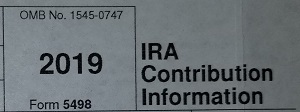Taxes when Re-depositing IRA Withdrawals

Photo credit: jb
If you take a withdrawal from an IRA (or pretty much any tax-deferral mechanism, such as a 401(k) account), under some circumstances you may be able to re-deposit the money back into the original account, or one with similar characteristics. One such circumstance is in tax year 2020, when the CARES Act has given the opportunity to re-deposit RMDs within a certain timeframe. (Click the link for more information on Re-depositing RMD in 2020.)
What kind of tax impacts are there for re-deposits?
To understand the tax impacts of re-depositing IRA withdrawals, you must first determine what is the exact nature of the withdrawal. The withdrawal could be made up of all tax-deferred money, or it could be partly tax-deferred and partly pre-taxed contributions. In addition, the distribution could be completely made in cash to you, or a portion of the distribution could have been directed elsewhere, such as withheld for income tax purposes or sent to a charity as a Qualified Charitable Distribution (QCD).
It should be noted that the re-deposits discussed here are rollover deposits – not regular annual contributions. Regular contributions do not impact withdrawals in the same manner as rollover deposits. These are two separate activities – and they can occur in the same tax year.
All funds tax-deferred. If the entire distribution was made up of tax-deferred money, if you re-deposit the entire amount into the source account or another tax-deferred account, there will be no tax consequences (assuming you do so in a timely manner). At the end of the year, your 1099R will show a distribution, but if the re-deposit is into the same account, the entire distribution will be indicated as non-taxed.
However, if you only re-deposit a portion of your distribution, anything left over will be considered taxable income.
For example, if you withdraw $10,000 from your IRA, and you’re otherwise eligible to rollover those funds (either in the “normal” 60-day manner or under the CARES Act rules), if you only re-deposit $5,000, then at the end of the year you’ll get a 1099R indicating a $5,000 taxable withdrawal from your IRA. This amount will be included as ordinary income on your tax return.
If you re-deposit the entire $10,000, then you’ll have no taxable income attributed to this withdrawal.
Some funds pre-taxed, otherwise tax-deferred. If some of your withdrawal comes from non-tax-deferred contributions, the portion that was not tax-deferred is not included as taxable.
Sometimes we make non-deductible contributions to IRAs or 401(k) accounts. When a withdrawal is taken from an IRA and there are non-deductible contributions included, each dollar of withdrawal is partly taxable and partly tax-free. If you re-deposit the entire withdrawal, you’ll only be able to re-deposit the tax-deferred portion into a traditional IRA. The remaining non-deductible portion may be converted to Roth IRA or simply kept as untaxed funds.
Part of the money directed elsewhere. If you directed a portion of your withdrawal to go somewhere else, such as withheld for taxes or directed to a QCD, a special problem comes up. How do you re-deposit the money into your IRA if you don’t have it?
Generally, unless you talk the charity out of the money, you’re either going to have to pay tax on the difference, or come up with the money from another source.
For example, let’s say you took a $10,000 withdrawal from your IRA, and had 20% withheld for taxes. This is a common situation for folks meaning to re-deposit RMD from 2020, for example.
This means that you only received $8,000 of the distribution – and you won’t see the withheld money until you file your tax return next year. Using the example of 2020, you need to re-deposit your RMD before the end of August.
If you don’t have another source of funds to come up with the additional $2,000 withheld for taxes, at the end of the year your 1099R will indicate a taxable distribution of $2,000. Granted this is money withheld to pay taxes, so a 100% withholding rate should be plenty to pay the tax on this $2,000 distribution (with a significant amount available for refund or to pay tax on other earnings).
However, the money for the re-deposit doesn’t have to be the exact same dollars that came out of the IRA. If you have $2,000 sitting in a passbook savings account, you could use that money to include with your $8,000 net withdrawal in order to make the complete re-deposit. If you make the complete re-deposit, at the end of the year this activity will result in zero taxable income.
The post Taxes when Re-depositing IRA Withdrawals appeared first on Getting Your Financial Ducks In A Row.
source http://feedproxy.google.com/~r/GettingYourFinancialDucksInARow/~3/yBhTsBSOnKA/
Comments
Post a Comment